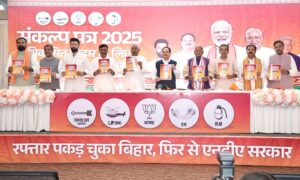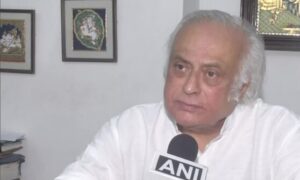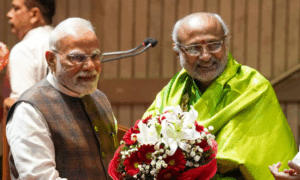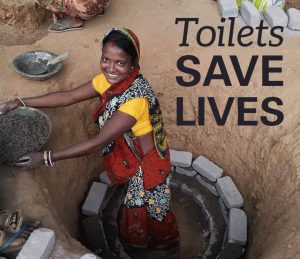
Source: Ministry of Drinking Water and Sanitation
Every year, India celebrates the Gandhi Jayanti on 2nd October. With commemorative spirit, the Government of India kick starts a set of initiatives under the flagship programmes. When Narendra Modi become Prime Minister of India, has set an ambitious target of Open Defecation Free India by October 2, 2019 when Mahatma Gandhi’s 150th birth anniversary will be celebrated. He launched the Swachh Bharat Mission at Rajpath in New Delhi after paying tribute to Mahatma Gandhi and Former Prime Minister Lal Bahadur Shastri, on their birth anniversaries. The Mission was bifurcated in two parts namely Swachh Bharat Mission (Rural) and Swachh Bharat Mission (Urban). As names suggest, two line ministries the Ministry of Drinking Water and Sanitation and the Ministry of Urban Developed were engaged in the Mission. Since then, the Union Government launched a series of interventions in the domain of sanitation. Before delving into the detail, there is a need to shed light on the line ministry – the Ministry of Drinking Water and Sanitation.
The Ministry of Drinking Water and Sanitation (MDWS) in Nutshell:
It is worthwhile to mention that Ministry of Drinking Water and Sanitation is an independent ministry which is headed by a Cabinet Ministry. Earlier, it was part of the Ministry of Rural Development. According to the Ministry, the Accelerated Rural Water Supply Programme (ARWSP) was the first major intervention in the water sector that started in 1972-1973. In order to accelerate coverage, the Government started a Technology Mission on Drinking Water in 1986.In 1991-92, this mission was renamed Rajiv Gandhi National Drinking Water Mission. In 1999, the Union Government created the Department of Drinking Water Supply (DDWS) under Ministry of Rural Development. As the Ministry stated, the first major sector reform project (SRP) was started in 1999 which was renamed as the Department of Drinking Water and Sanitation in 2010. Underlining the importance of WASH issues, the department was conferred the Ministry status by the Manmohan Singh Government in 2011. When Narendra Modi assumed the office, the Ministry grabbed the attention from various hues. With changing political priority, the government spearheaded various interventions around the WASH issues. Recently, Ms. Jean Gough, Regional Director, UNICEF stated, “We have seen the greatest increase in the use of #toilets in the last one decade because #India broke the silence and made cleanliness a political priority.”
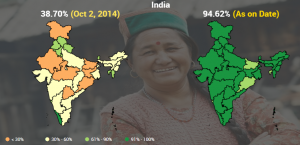
Source: Ministry of Drinking Water and Sanitation
The government claims that the rural sanitation coverage of India has now risen to 85 per cent. Through mobilization of rural communities, 7.4 crore toilets have been built across rural India, and as an outcome, over 3.8 lakh villages and 391 districts have been declared Open Defecation Free (ODF).
According to the Press Communique, “a recent survey conducted by an Independent Verification Agency across 90,000 households in over 6000 villages has found the usage of toilets in rural India to be 93.4 per cent.”
It further added, “Two independent surveys conducted in the past by the Quality Council of India in 2017, and National Sample Survey Organization in 2016, have pegged the usage of these toilets at 91 per cent and 95 per cent respectively.” As the Mission aims to achieve a Swachh Bharat by 2019, Indian Government observe the Swachhta Pakhwada from 2016 where ministries host a set of awareness programmes. In 2017, 50 Ministries and Departments observed the Swachhata Pakhwada. Similarly, J P Nadda, Union Minister of Health and Family Welfare inaugurated the ‘Swacchta Mela’ at AIIMS, New Delhi on 01, 2018 and urged people to internalize cleanliness and hygiene as a lifestyle. As a fitting tribute to Mahatma Gandhi on his 150th birth anniversary, Swachhata Hi Seva (SHS) 2018 started in September 2018. The government claims that it’s a Jan Andolan for Swachhata on the 4th anniversary of the Swachh Bharat Mission (SBM). In this backdrop, the Ministry of Drinking Water and Sanitation stated that all NGOs, schools, colleges, social, cultural and political leaders, corporate, government officials, collectors and sarpanches, are requested to accelerate Swachhata activities during the period of 15th September – 2nd October 2018. Consistent with this goal, the Ministry kick started a drive for # SwachhataHiSeva pledge and vow to contribute tirelessly towards the Clean India Mission. As of now, according to the official estimation, 7,264 schools and 2,718,934 students pledged for the SwachhataHiSeva. In order to accelerate the cleanness drive, the ministry has two other ways to contribute towards the Clean India Mission. These are Pledge to Segregate Waste and Mass Pledge by Organization/Institute. Some of the major activities of the Clean India for the common people: Mass Cleaning at Public, Places Waste Management Activities, Door to Door Swachhata Awareness, IEC Awareness Activities through “Nukkad Natak” & “Folk Songs”, Organizing Swachhata Rallies, Wall Paintings, Toilet Construction & Retrofitting Activities and Twin Pit Emptying. It is stated that 20 crore people planned to be mobilized during the fortnight. The office bearers take pledges to clean India and posts such visuals on the social media platforms and receive virtual appreciations.
Swachhata Hi Seva: Activity Options
- Mass cleaning of public places
- Waste collection drives
- Door-to-door meetings
- Awareess campaigns on swachhata
- Nukkad nataks, folk song and dances
- Village or School-level Rallies
- Wall paintings
- Segregation of solid waste
- Toilet pit-digging and toilet construction activities
- Building compost pits
Source: User Manual, Swachhata Hi Seva, Ministry of Drinking Water & Sanitation
Sustaining ODF outcomes through Swachhagrahis:
As the Swachh Bharat Mission aims to provide sustainable sanitation and hygiene services, the Government engaged volunteers in the rural areas who are known as Swachhagrahis. According to the official sources, they are local ASHA workers, ANMs, Anganwadi workers, water line man, pump operators, member of NCO/CSOs, youth organisations or from the general public living in villages. In order to streamline behaviour change with respect to key sanitation practices in rural areas, the government outlined key activities and incentive structure for these non-government employees.
It was reported that the World Bank approved US$1.5 Billion to Support India’s Universal Sanitation Initiatives. As Economic Times reported January 10, 2017, the World Bank has not released any tranche of a billion dollar 2015 loan to Prime Minister Narendra Modi’s ambitious Swachh Bharat Mission-Grameen (SBM-G) to address India’s poor sanitation practise in rural areas as the government has fallen short on its commitments.
In order to achieve the target, the government is collaborating with international institutions, corporates, NGOs, celebrities, ASHA workers, ANMs, Anganwadi workers women-centric groups, performers, students and many more.
As the United Nations Special Rapporteur on the human rights to safe drinking water and sanitation, Léo Heller visited India at the invitation of the Government from 27 October to 10 November 2017. What Heller noticed during the visit, “Indeed, I observed several cases of abandoned or poorly maintained toilets. Toilets may also be installed with doors that do not have locks, which negatively affect users of privacy. Conversely, I observed and heard of several cases where functioning toilets exist in public places but are left locked.” Following such observations, the Government of India rejected human rights allegations about water and sanitation programmes in the press communique.
It is work in progress and the government is desperately trying to engage the above-mentioned players. As the intervention entered in the fourth year which requires a comprehensive concurrent evaluation which is lacking. It is sad to note that the government overlooked the importance of the social audits which is an effective tool to assess the progress at the ground level. The government is focusing too much on the learning by sharing not the learning by doing. Glossy templates and ruthless tweets can’t solve the problem. These are easiest things to do. The age old practices are still dominating in villages. If one, an unbiased individual, is willing to assess the real picture, should venture into the rural areas. They demystify such blatant claims of the success. Depicting a real picture of the Clean India will a fitting tribute to Mahatma Gandhi on his birth anniversary.


